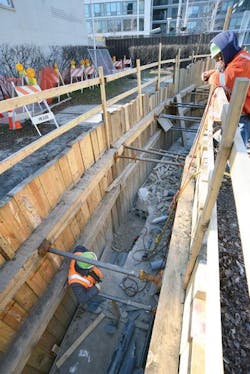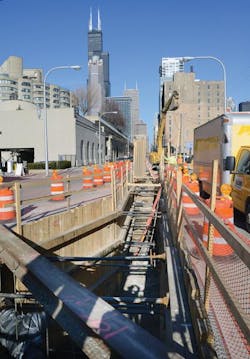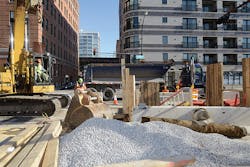As the nation’s third largest city, Chicago anchors a region of nearly 10 million people. As such, the system was in danger of becoming overloaded without the construction of a new double-circuit transmission line, according to studies from Commonwealth Edison’s (ComEd’s) transmission planning department and PJM Interconnection.
To meet the growing need for reliable power for the downtown business district, ComEd partnered with contractors and design firms to construct a new 345-kV transmission line. Because of the dense urban environment, the project called for an underground solution.
The line is routed through densely populated neighborhoods and a highly congested subsurface utility environment, so ComEd had to strike a balance between project planning, design, risk management and communication with stakeholders. To overcome significant engineering and construction challenges, ComEd partnered with contractors as well as its own internal departments, says Terrence R. Donnelly, executive vice president and COO for ComEd.
“The completion of this project is central to our ability to meet the growing demand for electricity and reliability, particularly in downtown Chicago,” he says. “More than 16 ComEd departments collaborated on this project. They demonstrated how important teamwork is in getting a project of this magnitude completed safely, ahead of schedule and under budget.”
Planning Out the Project
Over the course of the project, the workers constructed more than 6 miles of underground transmission line from the Burnham substation in Chicago’s South Side to the Taylor substation near the central business district. The design process for the project began in 2010, the construction of the civil portion of the installation began in August 2012, and the $148 million project was livened in March 2014.
In addition to the new line construction, the project included the conversion of two existing single-circuit high-pressure fluid-filled (HPFF) transmission lines into one double-legged single-circuit HPFF transmission line, new transmission equipment at four ComEd substations and upgraded control room equipment.
The new configuration increases the transmission capacity to meet the forecasted load demands and improves the system reliability during high load conditions. ComEd contracted the major portions of the design work to a team comprised of Sargent & Lundy and HBK Engineering.
ComEd also worked closely with the Chicago Department of Transmission (CDOT) in an effort to minimize disruption of traffic and maintain project efficiencies in high traffic areas. ComEd focused on street restoration efforts while CDOT used its budgeted funds to add bike lanes along State Street. ComEd’s cooperation with CDOT, other public utilities and private construction projects resulted in a fully resurfaced State Street from Congress Parkway on the south edge of the business district to 63rd Street.
Configuring the Underground System
The underground installations began at ComEd’s substation near Chicago’s South Loop neighborhood, bordering the southern edge of the “Loop,” which initially got its name from the looping route of streetcars that served as the transit hub of early downtown Chicago. The most significant design and construction challenge for the project was the creation of two new temporary tunnels, one under Interstate 55 or Stevenson Expressway, which has an average of more than 20,000 vehicles per day, and another under a Metra commuter rail system. The utility also used an existing ComEd tunnel under the Chicago River.
The new line uses 345-kV cross-linked polyethylene (XLPE) cable. The XLPE cable system has minimal operational and maintenance requirements. For example, it provides high operating and short circuit ratings, and it has lower dielectric losses than a HPFF cable system. To protect the cables from dig-ins, linemen placed the conductors in a concrete-encased duct bank consisting of nine 6-inch-diameter PVC conduits. As the construction progressed, the workers installed 17 manholes along the alignment in line with the duct bank system to be used for installing and splicing the 345-kV XLPE cable.
The existing HPFF transmission circuits were configured into a single double-legged circuit, thus providing ComEd a high-capacity, double-circuit transmission arrangement. At the Garfield substation, the circuits transition from underground to existing overhead transmission lines, further connecting the new circuits with ComEd’s southern suburban substations.
Upgrading Substations
To support the new line installation, ComEd performed major upgrades on its Taylor, Garfield, Calumet and Burnham substations. At the Taylor substation, the utility reconfigured the existing HPFF systems. In addition, the workers installed new XLPE terminations at new terminations on the gas-insulated switchgear and upgraded the control room.
The work at Garfield substation included reconfiguring the HPFF facilities, installing new XLPE facilities and updating the control room. The Calumet substation also underwent major upgrades. The 345-kV yard was expanded with new steel support structures, surge arrestors, inductor banks and an automatic throw-over switch as well as other switchgear. The upgrades at Burnham substation included installation of new 345-kV monopole transmission structures, new conductors and an upgraded control room with new relay panels and battery banks.
The substation upgrades were essential to increase the system capacity to accommodate for circuit reconfigurations and the addition of the new 345-kV line. The substation upgrades increased the grid resiliency and reliability as well as capacity to transmit power to downtown Chicago.
Confronting Challenges
During the project, the unknown presented significant but manageable challenges, says Donald N. Kleyweg Jr., HBK Engineering, and director of engineering on the project. For example, at the I-55 crossing, the drilling team had to develop an efficient way to drill through several feet of hard rock with a strength of 14,000 psi, which is three to four times the strength of normal concrete. The crew then had to continue drilling through clay to complete the installation, Kleyweg says.
“We had excellent geotechnical reports and four teams of experts, including ComEd engineering who collaborated to make sure we had the right plan, but it was important to remain flexible in this kind of environment,” he says.
The Metra railway crossing also presented a unique set of circumstances, he says.
“It’s challenging and stressful for construction crews to be working 25 ft underground on a rolling train system,” Kleyweg says. “To alleviate some of the stress, the construction leads keep the crews focused on performing the work safely and effectively, versus trying to expedite progress.”
The team also focused on the need to monitor the ground for movement and shifting. Because excavation was performed for the shafts and mining for a new tunnel, everyone had to establish and maintain very tight tolerances every step of the way, Kleyweg says.
While excavating the route, the team discovered evidence of Chicago’s rail history. As a result, the workers had to remove many sections of the electric trolley lines from the 1800s that have long since been covered in layers of pavement about 12 inches below grade, said Kleyweg. Presence of the rails was not a surprise, however, as much of the trolley lines are covered by street pavement and layers of granite paver bricks and rest on large rail timbers, thus complicating their removal.
The large number of affected customers and other parties also presented a challenge for ComEd’s project management team. To effectively communicate with all the participants, ComEd established a chain of command. ComEd also worked very closely with CDOT and other city officials to minimize the impact of street closures as construction proceeded through the South Side neighborhoods. The urban and subsurface utility infrastructure-related challenges were carefully considered during the design phase. The terrain, combined with Chicago’s severe cold and frequent snowfalls last winter, made an already difficult construction job even more challenging.
Another issue that ComEd faced on the job was that of high line capacitance. Because the cables are within close proximity to each other and the earth, the capacitance can cause charging currents to flow into the transmission line. As these currents are directly correlated to the line voltage, high voltage greatly limits the length of the underground transmission lines.
To solve this problem, the utility carefully evaluated the line capacitance issues during the design process. To even out the charging current issues, ComEd added two 80 MVAR inductor banks to the Calumet substation. The inductor banks essentially introduce currents, negative to the charging currents, and cancel out the effects of the line capacitance.
Focusing on Safety and Productivity
Based on ComEd’s previous experience with large underground transmission projects, the utility identified safety and quality as the two main areas of focus. By emphasizing safety on the job site, ComEd produced an excellent OSHA incident rate over the life cycle of the project.
Quality was also a major factor on the job. For example, ComEd put the installed conduit through multiple quality-control exercises prior to the installation. The pre-construction testing allowed for the discovery of design errors prior to implementation. The time invested in planning for the civil work also paid off during the construction process, keeping the project on schedule.
With the completion of the Burnham-Taylor double-circuit transmission line, ComEd has increased its capacity to support increasing load demand of Chicago’s downtown business district. Further, the new transmission line increases the reliability of electric service throughout downtown. In addition, the system is now more resilient as 345 kV can be fed to heavy demand areas through multiple transmission circuits.
William P. Nolan ([email protected]) is a senior transmission project manager for ComEd and a registered professional engineer.
Mentioned in this article:
Chicago Department of Transportation | www.cityofchicago.org/transportation
Commonwealth Edison | www.comed.com
HBK Engineering | www.hbkengineering.com
Sargent & Lundy | www.sargentlundy.com



